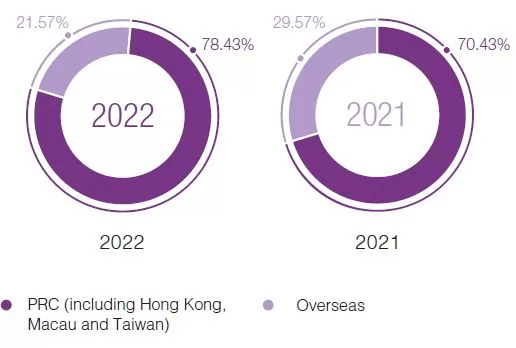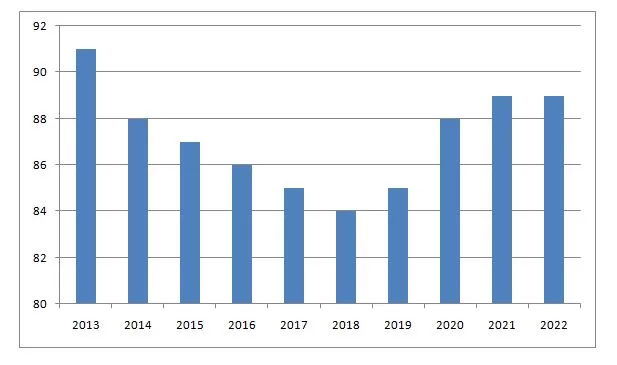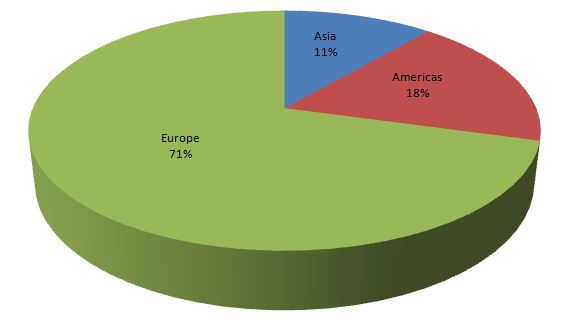SWOT Analyses

SWOT is an acronym for strengths, weaknesses, opportunities and threats related to organizations. The following table illustrates BYD SWOT analysis Strengths 1. Vertical integration and cost advantage 2. Market leadership at the global scale 3. Leadership in technological capabilities 4. Massive manufacturing scale Weaknesses 1. Brand image associated with the perception Chinese quality being low 2. Overdependence on domestic market 3. Too broad range of business 4. Dependence on Chinese government EV subsidies Opportunities 1. International market expansion 2. Formation of strategic partnerships 3. Increasing relevance and popularity of EV 4. Technological advancements Threats 1. Intensifying competition 2. Trade conflicts between China and USA 3. Issues in sourcing key components 4. Global economic slowdown BYD SWOT Analysis Strengths in BYD SWOT Analysis Vertical integration and cost advantage The bedrock of BYD’s cost leadership lies in its deep vertical integration. Unlike traditional automakers who rely on a constellation of external suppliers, BYD owns and operates its entire supply chain, from battery production to semiconductors, electric motors, and even key vehicle components. This single-source approach empowers BYD with several advantages. Firstly, it eliminates the markups and negotiation complexities associated with external suppliers, offering greater cost optimization. Secondly, it enables streamlined communication and collaboration across the entire production chain, allowing for quicker problem-solving and flexibility in adapting to market demands. Analysts estimate this vertical integration translates to a 25-30% cost advantage over competitors, a significant edge in the fiercely competitive EV market. But vertical integration goes beyond mere cost-cutting. It empowers BYD with unparalleled control over quality and consistency. By managing every stage of production, BYD can ensure strict adherence to its own exacting standards. This reduces the risk of defective components or production bottlenecks, further contributing to lower overall costs. The Blade Battery, a BYD innovation, exemplifies this. Its unique design…

SWOT is an acronym for strengths, weaknesses, opportunities and threats related to organizations. The following illustrates Marriott SWOT analysis: Strengths 1. Diverse portfolio of brands 2. Global presence 3. Strong loyalty program 4. Asset-light business model Weaknesses 1. Labour issues 2. Brand image damaged due to data breach Opportunities 1. Targeting millennial and Gen Z segments 2. Increasing focus on alternative lodging 3. Focusing on emerging economies 4. Entering into adjacent industries Threats 1. Increased competition from alternative lodging 2. Currency fluctuations 3. Geopolitical tensions 4. Global pandemic Marriott SWOT Analysis Strengths in Marriott SWOT Analysis 1. Diverse portfolio of brands. Marriott International has 30 brands[1] in its portfolio appealing to the needs and wants of a wide range of customer segments. The company has something to offer every type of traveller, from budget-minded backpackers to luxury-seeking executives. This diversity gives the hotel chain substantial competitive advantage. Specifically, it allows the company to reach a wider range of customers. A traveller looking for a budget-friendly hotel is just as likely to book a room at a Fairfield Inn by Marriott as a traveller looking for a luxury hotel is to book a room at a Ritz-Carlton. 2. Global presence. Marriott is the largest hotel chain in the world and operates properties in 138 countries and territories[2]. Such a global presence gives the company a number of advantages. For example, global presence gives the company a competitive advantage over smaller hotel chains. Smaller hotel chains typically do not have the resources to expand into new markets and build new hotels. Marriott’s global presence allows the company to quickly and easily expand into new markets and compete with local hotel chains. Second, the hotel chain’s global presence allows it to leverage its brand recognition. Marriott is one of the most…

SWOT is an acronym for strengths, weaknesses, opportunities and threats for organizations of all types. The following table illustrates Netflix SWOT analysis: Strengths 1. First mover advantage 2. Corporate culture 3. Original content 4. Global presence Weaknesses 1. Dependence of business model on other companies 2. High level of indebtedness 3. Over-dependence on North American home market 4. Compromised customer service Opportunities 1. Forming strategic partnerships 2. Product line extension 3. Benefiting from AI 4. Increasing focus on locally adapted content Threats 1. Failure of new co-CEOs 2. Video piracy 3. Loss of customers due to rising prices 4. Global market saturation Netflix SWOT Analysis Strengths in Netflix SWOT Analysis 1. Although Netflix did not invent on-demand video streaming, it has proved that this business model can be viable. Netflix was the first company to scale video streaming globally and the company name has become synonym for subsection based on-demand media with huge content library. First mover advantage is a considerable strength for Netflix because it increases brand recognition considerably and establishes the company’s serves as industry standards. 2. Netflix is famous for its non-orthodox corporate culture. The entertainment services provider encourages decision-making by employees at all levels and shares information openly, broadly and deliberately. Moreover, internal communications at the largest streaming service in the world are candid and direct and this also relates to employee performance feedback. Sophisticated corporate culture established by co-founder and former long-term CEO Reed Hastings has played an integral role in the success of the company and it is one of the formidable strengths associated with the business. 3. Netflix was among the first streaming platforms to produce its own content starting from 2011. Over the years the entertainment services provider was able to produce critically acclaimed shows worldwide such as House…

SWOT is an acronym for strengths, weaknesses, opportunities and threats related to organizations. The following table illustrates Apple SWOT analysis: Strengths 1. High quality, design and performance of Apple products and services 2. Brand value of more than USD 3 trillion 3. High profit margin 4. Solid financial position of the business 5. Sophisticated supply-chain infrastructure Weaknesses 1. Lack of innovation 2. Decreasing sales of iPhones 3. Higher prices than competition 4. Incompatibility of Apple products and services with other products and services for users 5. Limited customazation options of products Opportunities 1. Further increasing concentration on Services business segment 2. Increasing focus in research and development 3. Product diversification 4. Formation of strategic partnerships 5. Increasing focus on green technology Threats 1. Quality problems with negative effects on sales and Apple brand image 2. Intensifying competition from China and India 3. Being found to have infringed on intellectual property rights 4. Reputation damage due to the tax scandal 5. Disruptive innovation by competitors Apple SWOT analysis Strengths in Apple SWOT Analysis 1. High quality of Apple products and services in terms of design and performance is the main strength of the company. Co-founder and late CEO Steve Jobs never compromised design and functionality because of the cost of raw materials and manufacturing. The same principle persists to this day. The tech giant pursues differentiation business strategy and effectively differentiates its products and services with high quality, design and performance. Moreover, highly sophisticated Apple ecosystem plays an instrumental role in maintaining brand loyalty and consequently sustaining market share in the global scale. Specifically, third-party products are not usually compatible with Apple products and all products belonging to Apple portfolio work well with each-other. Thanks to services such as iCloud, airplay, and airdrop, you can start a task in on…

SWOT is an acronym for strengths, weaknesses, opportunities and threats related to organizations. The following table illustrates Nvidia SWOT analysis: Strengths 1. Global leadership in GPU market 2. Unique position to benefit from increasing popularity of AI 3. More than 370 partnerships revolving around self-driving cars 4. Advanced R&D capabilities Weaknesses 1. Dependency of the majority of profits on graphics cards alone 2. Dependence on 3rd parties due to fabless manufacturing 3. High operational costs 4. Limited product differentiation. Opportunities 1. Benefiting from increasing popularity of AI 2. Acquisitions of other technology companies 3. Expansion into new industries 4. Growth in the cloud computing market Threats 1. Intensifying competition 2. Supply chain disruptions 3. Regulatory changes 4. Disruptive innovation Nvidia SWOT analysis Strengths in Nvidia SWOT Analysis 1. Nvidia is the global leader in GPU market with market share of more than 70%. The company has benefited from the first mover advantage. Nvidia’s GeForce 256 is widely considered the world’s first GPU. Furthermore, at the moment Nvidia GeForce RTX 3090 TI is considered as the best-performing GPU in the world.[1] The global market leadership is a considerable strength for the multinational technology company in terms of brand image and revenue potential. 2. Nvidia produces advanced chips required to train and run artificial intelligence (AI) networks and as such the company hugely benefiting from the increasing integration of AI into various aspects of personal and professional lives for millions of people. Other competitors such as AMD, Cisco and Juniper also set to benefit from AI, however, Nvidia in particular had made earlier bet and the company currently has become synonym with AI. Furthermore, on May 30, 2023 Nvidia market capitalization crossed USD 1 trillion threshold for the 1st time after its artificial intelligence prospects vaulted the chipmaker into an elite club…

SWOT is an acronym for strengths, weaknesses, opportunities and threats related to organizations. The following table illustrates WeWork SWOT analysis: Strengths 1. Strong liquidity 2. International presence 3. Experience 4. Brand recognition Weaknesses 1. Business has not achieved profitability 2. High level of indebtedness 3. Damaged company image 4. Business model easy to replicate Opportunities 1. Entering into strategic collaborations 2. Strengthening WeWork ecosystem 3. Finding new sources of competitive advantage 4. Increasing marketing efficiency Threats 1. Inability of Sandeep Mathrani to turn around the business 2. Members seeking payment concessions or deferrals or cancellations 3. Emergence of new competitors with innovative business models 4. Changes in customer attitudes towards shared workspace WeWork SWOT Analysis Strengths in WeWork SWOT Analysis 1. WeWork has a strong liquidity. As of December 31, 2021, the company had access to USD2.0 billion of liquidity in the form of cash and commitments from its lenders. Strong liquidity offers a range of benefits for the workspace provider such as ability to meet short-term debts and dealing with unforeseen circumstances. 2. The global flexible workspace provider operates a network of 756 locations in 38 countries as of December 2021. Global presence offers a range of advantages for the workspace provider. These include economies of scale, access to local talent and opportunity to increase revenues. 3. WeWork had to deal with a range of serious issues such as ineffective management, severely flawed corporate culture and starting many initiatives at the same time. These setbacks damaged the brand image to a considerable extent. At the same time, it can be argued that the process of having to go through these problems have been a valuable experience for employees at all levels. Specifically, thanks to these issues WeWork employees at all levels are more mature now and they…

SWOT is an acronym for strengths, weaknesses, opportunities and threats related to organizations. The following table illustrates Starbucks SWOT analysis: Strengths 1. Extensive, but focused brand portfolio 2. High profit margin and solid financial position 3. Market leadership in the global scale 4. Customer services and brand positioning 5. Increasing presence in emerging economies Weaknesses 1. Overly dependence on the US market 2. Overly expensive prices 3. Brand image weakened due to a number of incidents 4. Extensive dependence of revenues on Arabica coffee beans price 5. Imitable products and competitive advantage Opportunities 1. Diversification of business 2. Increased focus on organizational ethical behaviour 3. Entering into strategic cooperation 4. Reforming the pricing structure 5. Increasing focus on mobile ordering Threats 1. Leadership failure by new CEO Laxman Narasimhan 2. Dramatic increase of coffee beans costs 3. Decline in consumption of coffee due to health concerns 4. Emergence of direct and indirect competition 5. Disruption in supply-chain Starbucks SWOT Analysis Strengths in Starbucks SWOT Analysis 1. Starbucks Corporation maintains an extensive, yet highly focused brand portfolio. At the same time, all brands belonging to Starbucks portfolio including Teavana, Tazo, Seattle’s Best Coffee, Evolution Fresh, La Boulange and Ethos are popular drinks and beverages of premium class. The company also sells merchandise products such as coffee- and tea-brewing equipment, Verismo® System by Starbucks, mugs and accessories, packaged goods, books and gifts. Starbucks is able to apply its competitive advantage and extensive experience in the promotion and sales towards each product within its portfolio thanks to the shared features of these products associated with high quality for a premium price. 2. In fiscal year 2021 Starbucks generated consolidated revenues of USD 29,1 billion an increase of 24% compared to the previous year. The global coffeehouse chain enjoyed a…

SWOT is an acronym for strengths, weaknesses, opportunities and threats related to organizations. SWOT analysis is a strategic tool that helps businesses to analyse internal and external factors affecting the bottom line. Strengths and weaknesses are internal factors that can be influenced by the company. Opportunities and threats, on the other hand, are external factors that have to be taken into account in strategic decision-making by the senior management. The following table illustrates IKEA SWOT analysis: Strengths 1. Market leadership in the global scale 2. Democratic design concept 3. Competency in cost-cutting through product and process innovation 4. Brand value and solid financial position 5. Vast, yet focused product range Weaknesses 1. Weak presence in Asia 2. Damaged reputation due to a series of incidents 3. Competitive advantage difficult to sustain 4. Lack of differentiation of IKEA products and services 5. Lack of flexibility due to large size Opportunities 1. Increasing emphasis on CSR 2. Increasing presence in developing countries 3. Adding premium range of products into portfolio 4. Strengthening cost leadership competitive advantage through technological innovation 5. Benefiting from increasing digitalization of various business processes Threats 1. Decline in demand due to increase in consumer income 2. Unsustainability of ‘democratic design’ concept 3. Emergence of competition from Asia 4. Increasing costs of raw materials 5. Global economic and financial crisis SWOT Analysis summary for IKEA Strengths in IKEA SWOT Analysis 1. IKEA is an undisputed market leader in the global market of home improvement and furnishing. The Swedish furniture chain has 11 franchisees operating in more than 500 locations in 63 countries.[1] Additionally, the furniture retailer has 22 Pick-up and Order…

SWOT is an acronym for strengths, weaknesses, opportunities and threats related to organizations. The following table illustrates McDonald’s SWOT analysis: Strengths 1. Global market leadership 2. Brand value and brand awareness 3. Sustainable business model 4. High level of profitability 5. Effective utilization of digital technologies Weaknesses 1. Unhealthy food on the menu 2. Declining brand image 3. High employee turnover 4. Negative publicity 5. Low differentiation Opportunities 1. Enhancing focus on nutritional menu 2. Product differentiation 3. Improving CSR aspect of the business 4. Reviving the brand image 5. Increasing the extent of localization in international markets Threats 1. Food safety concerns 2. Fast food market saturation in developed countries 3. Lawsuits against the company 4. Currency fluctuations 5. Competition from quality burger chains McDonald’s SWOT analysis Strengths in McDonald’s SWOT Analysis 1. McDonald’s is an undisputed market leader with more than 40000 restaurants worldwide. The fast food giant has a global market share of about 43,8% and its closest competitor Yum Brands that comprises KFC, Pizza Hut, Taco Bell and The Habit Burger Grill has a market share of only 30,9% in the global fast food industry.[1] Market leadership is a considerable strength for McDonald’s in terms of generating cash flow and profits for medium and long-term perspectives. 2. McDonald’s is one of the most valuable brands in the world. According to Forbes McDonald’s is No. 10 most valuable brand in the world with the brand value of USD 46,1 billion[2]. Similarly, Interbrand considers McDonald’s No.9 most valuable brand in the world with the brand value USD 45,87 billion.[3] Brand value and brand awareness are proved sources of competitive advantage. Specifically, brand value is an indicator of a high level of consumer loyalty and it offers a wide range of advantages that include negotiating power with customers…

SWOT is an acronym for strengths, weaknesses, opportunities and threats related to organizations. Amazon, as the e-commerce and cloud computing company worldwide needs to build upon its strengths at the same time reducing negative impact of its weaknesses on the bottom line. Moreover, it is important for the company to take advantage of opportunities and adopt a proactive approach in dealing with threats in the marketplace. The following table illustrates Amazon SWOT analysis: Strengths 1. Market leadership in the global scale 2. Strong ecosystem of products and services 3. Cost leadership due to efficient cost structure 4. Customer-centricity 5. Brand value Weaknesses 1. Business model that can be imitated 2. Seasonality of the business 3. Weak competitive position of Amazon’s Fire Phone 4. Damage to the brand image due to tax avoidance controversies in USA, UK and Japan 5. Working conditions for warehouse workers Opportunities 1. Diversification of e-commerce business segment 2. Increasing focus on own brand products and services 3. Increasing physical presence of the brand 4. Developing more local sites in international markets 5. Intensifying backward integration Threats 1. Patent infringement and other lawsuits against the company 2. Weakening of industry entry barriers 3. Threats to online security 4. Andy Jassy failing to fill Jeff Bezos shoes effectively 5. Backlash towards the brand Amazon SWOT analysis Strengths in Amazon SWOT Analysis 1. Amazon is an undisputed market leader in online retail and cloud computing segments. The e-commerce giant generated USD 386 billion revenues and earned a net income of USD 21,3 billion in 2020 alone[1]. Dubbed as The Everything Store, Amazon sells hundreds of millions of products of its own and third-party sellers. Current market leadership position grants the tech giant upper hand in the competition in a number of ways such as economies of…
